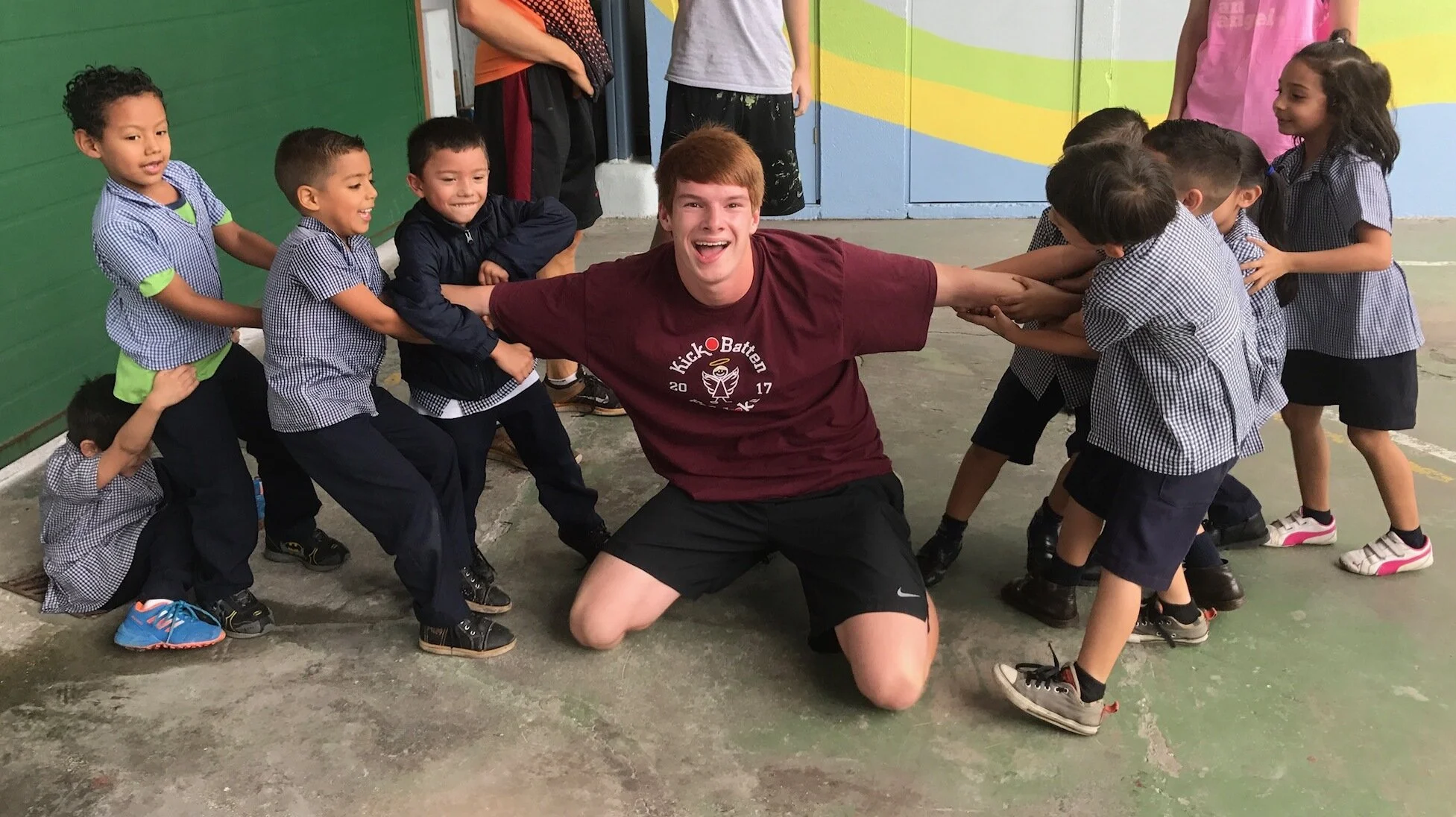When you have young children like Emily and me, it seems like there is a continuous string of “firsts” that happen. On Friday, they got to see me cry for the first time. And it wasn’t just a few tears. I broke down and wept, right there at the kitchen table. Emily came over and held me, and then Julian did the same. Madeleine just stared in confusion. The fact that our four-year-old’s first instinct was compassion - holding me tightly and trying to console me - just made me cry more. I was now crying tears of sorrow and joy.
I know enough to realize that tears like that are not usually just from one thing, but rather all the things that have been suppressed and building up inside. Given all that has been on my shoulders the past few years, I was definitely due for a big cry. But the presenting issue – the immediate source of my grief was an email that I received from a parishioner at the former parish where I served as the Associate Rector for Youth & Young Adults. It was from the mother of one of the youth with whom I was closest – Reid. Reid – who was 20 - committed suicide a couple of weeks ago. I was notified of this tragedy the day that it happened, and have held my grief at bay, mostly due to shock, numbness, and my not being present with that community in Jacksonville. But when I finally heard directly from his mother, Lisa, my grief was finally crystallized in a way that it needed to be. I’ve been fervently praying for Reid, his family, and Reid’s tightly-knit group of peers for two weeks. But I simply needed to cry.
I knew Reid as well as any of the youth at St. Mark’s. My very first day on the job there, I hopped in a van with our Youth Director and 5 rising 7th graders. We drove to Chattanooga, TN for a weeklong mission trip. The first meal we had together was hot Krispy Kreme doughnuts. I wore the Krispy Kreme hat the rest of the drive to Chattanooga. I learned after the fact that they were really bummed that the new priest was coming with them on the trip. They were afraid I’d be too old, serious, and boring. They loved their youth director Ayana…why couldn’t she just take them?
As it turns out, those 3 boys and 2 girls and I hit it off swimmingly, and I remain close with all of them to this day, albeit mostly through Instagram. Most importantly, those 5 kids and their other peers from the St. Mark’s Youth Group are still extremely close with one another – even though they have dispersed all over the country to various colleges. When they were in middle school and high school, they didn’t all go to the same schools. Some went to public schools and some went to private schools. Some played sports and others were into Boy Scouts. But they all were committed to their youth group at their church.
I don’t want to romanticize this Youth Group – there were other groups around town that were much larger. There were always those parents who complained that our youth group wasn't as good as the Methodist or Presbyterian ones in the neighborhood. And there were youth at St. Mark’s that weren’t the least bit interested in our youth group, or any other one for that matter. But that group of teens that did come to youth group every Sunday formed bonds with one another, their adult mentors - and most importantly with Christ - that will last a lifetime.
Reid came from a very stable, loving, and supportive family. His parents Bob and Lisa and his older brother Drew loved Reid to pieces, and he adored them as well. His older brother Drew was his hero. So, needless to say, we were all shocked when we heard the tragic news of his suicide.
The email that Reid’s mother Lisa sent to me Friday helped explain some of the back story, and also explains why I was brought to such profound sorrow when I read it. With her permission, I am sharing some of what she wrote:
Dear Richard,
It was so good to hear the sound of your voice on my voice mail. Both Reid and I were so looking forward to reconnecting with you when he came over to [The University of West Florida] for school this Fall. We had literally just talked about it, and about how he might sometimes come to Santa Rosa [Beach] for Sunday service. I was planning to let you know in person when we brought him over for college, what he was dealing with and ask you to be in our "village.”
Reid developed General Anxiety Disorder sometime last fall while a student at Sewanee. When he came home for the holidays, we got him to a doctor and therapist, who put him on medication. His prognosis was very good the entire time. They thought he might be on medication for about a year and then be able to go off. His illness is characterized by, not the everyday anxiety that we all feel, but by runaway, racing thoughts that kept people awake all night and exhausted during the day. He seemed to have overcome it and was doing so very well: girlfriend, new college with his best friend, making/selling fishing lures, writing a fishing blog, woodworking, and working at the marina where they had promoted him to manager of the summer interns. He hated being on the medication and got permission from his doctor to go off because he seemed to be doing so well. The anxiety/depression returned so swiftly it was a shock to all of us, and a huge disappointment to him. I think he thought the whole thing was behind him, rather than, as we came to learn, something that he would battle for years. The illness slowed him down and prevented him from living as he wanted to. He was truly a gift to me every day for 20 years, and I honestly, secretly always felt he was a gift from God. Reid was the same at home and in the community; a true sweetheart. I know you were close to several of the boys and I wanted to make sure you knew about Reid. I hope we'll connect sometime in the future anyway. Thank you for your outreach to Reid when you were at St. Marks. We all still miss you.
God Bless You,
Lisa
I am sharing Reid’s story with you because I want to highlight the critical importance of two things: first, mental illness is real. And it can be deadly. There is no parent, sibling, loved one, peer group, Church, youth program, youth minister, or priest who can “fix” mental illness. It is a disease just like diabetes or any other diagnosable illness that requires a lifetime of medication, professional help, and lifestyle adjustments. And while it is sad, unfortunate, and even maddening; it is not shameful. I can’t imagine what Reid must have been feeling to end his own life. But I knew Reid well, and for him to do that highlights the profound reality of mental illness.
The other point I would like to make is that I don’t think that God, the Church, or Reid’s experience in the youth group at St. Mark’s failed him. A fair question for us to ask is that if Reid had such a wonderful family and such a wonderful Church, then how could he have possibly felt so despairing and hopeless? Did Reid’s relationships with Christ, the Church, and his youth group mentors and peers fail him? I think that these are the sort of questions that haunt all of us who have loved ones who make the tragic decision to take their own lives.
I wish that if we could check all of the boxes that point to a stable, happy, healthy, and grounded Christian life, we would be guaranteed lifelong health and happiness. But that simply isn’t the case. None of us are immune to the setbacks that life can present us, and none of are immune to tragedy. But what the St. Mark’s community provided for Reid and his family and friends aren’t for naught.
First of all, I believe that Reid knew God, and given his illness, Reid decided that he was ready to be with God. Reid’s suicide wasn’t a rejection of God, but a desperate cry out to God for God’s immediate love, healing, and peaceful presence. And I believe that God heard and responded to Reid’s cry with mercy, grace, and compassion. God would never reject his own child’s desperate need to be held in his very own arms. And I believe that Reid knew that, felt it, and longed for it. Reid’s lifelong journey of Christian formation sadly didn’t provide Reid the resources to help overcome his profound illness. With some people, that might have been the case. That is our hope, after all. But when it is not the case, as with Reid, we can rest assured that Reid’s relationship with Christ allowed him to know Who he belonged to. It allowed Reid to remember that in his baptism, he was marked as Christ’s own forever. I believe that Reid knew that, and he knew where he was going and Who he was going to be with when he ended his life.
In the wake of this tragedy, the youth group community at St. Mark’s also provided the space for Reid’s peers and former adult mentors to grieve when they heard the tragic news of his death. Most all of them were living at home with their parents because their colleges were closed due to the pandemic. The youth leader Ayana and I both have moved on from St. Mark’s, but Ayana lived close enough to Jacksonville to go back and help host a gathering for all of Reid’s former youth group friends and mentors. So even though those kids had gone off to different colleges, and their youth leader and youth pastor had moved away to other churches, when tragedy struck, they all came back together in that same youth room where they used to gather on Sunday nights. They needed that space, and one another to help them make meaning during this time of grief.
Even if some of them hadn’t graced the door of a church once they went off to college, when they needed it the most, their church space and church community were there for them. Christ was there for them. Those relationships were formed over the course of the first 18 years of their lives. They served as acolytes together. They took confirmation class together. They went to Happening together. They went to Camp Weed together. They went on mission trips together. They came to know and love one another within the context of their church youth group community. And they came to know and love Christ within the context of their church youth group community.
So to me, the question isn’t, “How did the Church fail Reid?” The question is, “Where would Reid’s peers be if they didn’t have those profoundly important relationships with one another and with God when this tragedy happened? How would they cope? How would they begin the grief process of making meaning of this tragedy?”
As I was writing this sermon, I was also helping make arrangements for next weekend, when we will host a candidate who has applied for our newly-created Director of Family Faith Formation position at Christ the King. Our Search Team is very excited about this possibility, and we ask that you hold this process in your prayers. I know I sound like a broken record, but I can’t emphasize enough how grateful and excited I am that were are finally committing to having a full-time professional staff person to serve as a shepherd for our children, youth, and their families. Reid and his peers had fun with their youth group at St. Mark’s. But more importantly, while they were having fun, they were developing deep-seated, lifelong relationships with Christ, with one another, and with adult mentors who are still active in their lives.
When Julian was hugging me the other night as I was crying, he asked me, “What’s wrong, Daddy? Why are you crying?” I told him that somebody who was very special to me died. Julian then said, “It’s ok, Daddy. He is with God now. And God heals people who are sick.” Bear in mind, if my priest tried to console me this way, I would be horrified. But I was profoundly moved by Julian’s sweet compassion as he tried to help me feel better. Julian then went on to say, “I know what we can do! We can use my blocks to rebuild Reid. We can build him up so he can still be with you.” So we went over and began building with his blocks. Julian said, “We have 20 blocks. Will that be enough?” I said, “Yes! That is perfect! Reid was 20 years old, so we have a block for each year.” As Julian and I began to build an image of Reid back up with the blocks, I couldn’t help but to think about how God builds us back up when we fall. And children’s and youth ministries are some of the most vital building blocks for a church to have. They help establish a foundation upon which we can stand when we most need one another, and when we most need the peace and love of Christ.










